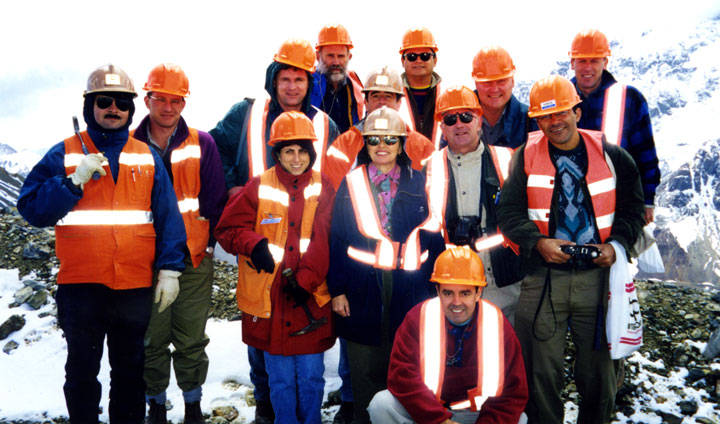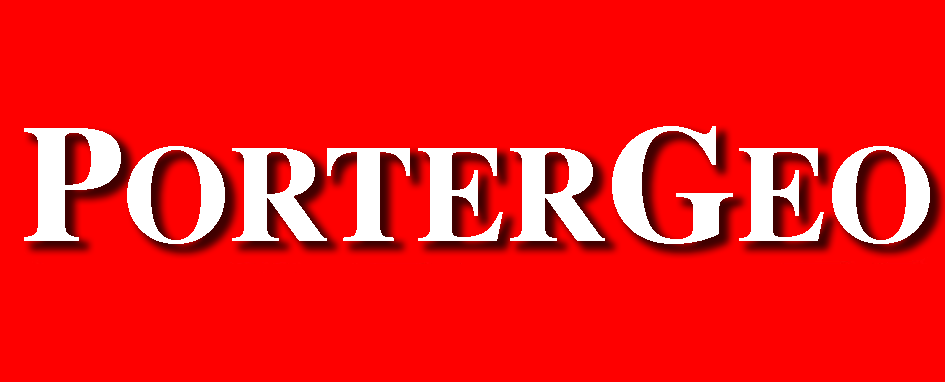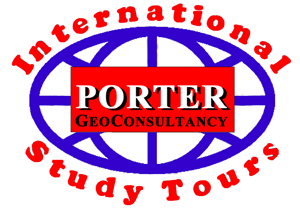| |||||||||||
| |||||||||||
| |||||||||||
|
Image: Members of the South American Module group at Los Bronces.
 Porphyry Related Copper/Gold Deposits
Porphyry Related Copper/Gold Deposits in the Cordillera of the Americas By Mike Porter
The flashy latin waiters, in their long white aprons, bustled around the table, serving thick steaks and parilladas to the twelve geologists of the Australian Mineral Foundation's Cordillera '98 Study Tour.
Behind the long table, and within easy reach, was a rack extending from floor to ceiling, and the length of the wall, stacked with fine Argentine wines.
They were in the El Palenque Parillada, on the corner of Avenidas Corrientes and Balcarce in San Miguel de Tucuman, western Argentina. It was now nine o'clock at night, and a vanguard of locals were just starting to filter in from the street, adding to the atmosphere in the restaurant with their animated conversation. That morning, the study tour group had taken a chartered turbojet to the Baja de la Alumbrera copper-gold mine, some 150 km to the southwest, in the high Andes. Before landing they circled the deposit. The newly commenced open pit, embracing a core of darker potassic alteration and ore, was centred in the baja, or topographic basin. The pit was surrounded by a striking, biscuit coloured halo of phyllic alteration which extended half way up the walls of the baja. It was fringed in turn by the weak red tinges of the broad outer propylitic zone. This then faded into the dark grey, bare, ragged ridges of andesite that overlooked the mine. They had spent the day, first being briefed over maps and sections in the geology department, and then into the pit to see the orebody and its hosts, before returning to Tucuman in the late afternoon. This then, was the final dinner the full group would have together on the South American module. Over the past eleven days in Chile and Argentina they had visited seven of the greatest porphyry related copper and gold deposits in the world. The group included geologists with all levels of experience, up to exploration managers. They had come together in Santiago, Chile, on the evening of Sunday March 15, from Africa, Australasia, Southeast Asia, southern Asia, and four countries in South America. Tonight, in the restaurant they talked easily with a familiarity that came from travelling together for nearly two weeks, and sharing a unique and rewarding professional experience. They reminisced on their days together in buses and aircraft during more than 7000 km of travel. The hotels, the early morning starts and late nights, the Santiago seminar, the technical discussions and exchanges that arose along the way. But most of all the incomparable mine visits. Now however, the module was all but over. Next morning the group would disperse across the world. Some would go home, while the remainder would re-assemble in three days time, joined by new starters, in Tucson, Arizona, to commence the North American module. By its end in Vancouver, Canada, on Wednesday April 8, the tour would take in fifteen of the classic porphyry related copper and gold deposits in the cordillera, of both South and North America. The tour took the participants to some remote and magnificent locations, spread over 11 000 km of the Cordillera, in four countries, and on two continents. It brought together a group of professionals from around the world to travel together and exchange experience and perspectives from their varying backgrounds. Although rewarding, the itinerary was compact, and as demanding as any other work they had done. It presented a unique and exciting opportunity for the professional advancement of the participants, tinged with a certain sense of adventure. Two Separate Modules The subject of the tour was the "Porphyry Related Copper & Gold Deposits in the Cordillera of the Americas". It was divided into two separate modules, the first of eleven days visiting seven porphyry related copper and copper-gold deposits in South America. Six were in Chile and one in Argentina. This module commenced with a one day seminar in Santiago, Chile, also attended by fifty geologists from the local industry. It ended at Tucuman in western Argentina. The second module of ten days commenced in Tucson, Arizona in the United States, on Monday March 30, with a one day workshop presented by Professor Spencer Titley of the University of Arizona, Tucson. This was followed by visits to five porphyry copper mines in Arizona and one copper-gold deposit in Utah, before proceeding to Vancouver, Canada. The module continued with a workshop at the University of British Columbia arranged and led by Professor John Thompson. It was concluded with two mines in central British Columbia. The ore deposits visited are some of the greatest in the world. The south American module commenced with the Los Bronces and El Teniente copper mines in the south near Santiago, then north to the rich El Indio-Tambo gold-copper and gold only mines. Travelling north again through Antofagasta, the Chuquicamata, El Abra and Escondida copper mines were visited, before proceeding to Argentina to take in the Alumbrera copper-gold orebody. In North America the Mission, Sierrita, San Manuel, Ray and Silver Bell copper mines were visited in Arizona, and the vast Bingham Canyon copper-gold-molybdenum deposit in Utah. These are all in the USA. In Canada the group saw the Highland Valley copper and Afton-Ajax copper-gold pits in British Columbia. Organisation The tour was designed for maximum impact in the minimum time, in recognition of the value of the time of key industry staff. It was also split into the two separate modules, to allow participants to select the section in which they were most interested. Alternatively companies could expose different staff members to particular areas and deposits. The itinerary, while very concentrated and compact, had essential rest days to avoid fatigue and saturation. All of the planning, costing and tedious organisational detail of the tour were carried out by the AMF. All the participants had to do was get to the starting point with their field and travel gear, and to read the preparatory literature assembled by the AMF. This literature had been delivered before hand, along with a travel pack which included a sturdy haversack, the detailed itinerary, a geological summary, and other useful items. This preparation by the AMF permitted costs to be kept to a minimum, while removing all of the hassle and allowing the participants to focus on the main goal - some of the greatest porphyry related copper and gold deposits in the world. Return to TOP
Porter GeoConsultancy Home
| More on This Tour
| Other Tours
| About AMF
T M (Mike) Porter of Porter GeoConsultancy Pty Ltd. | |||||||||||











